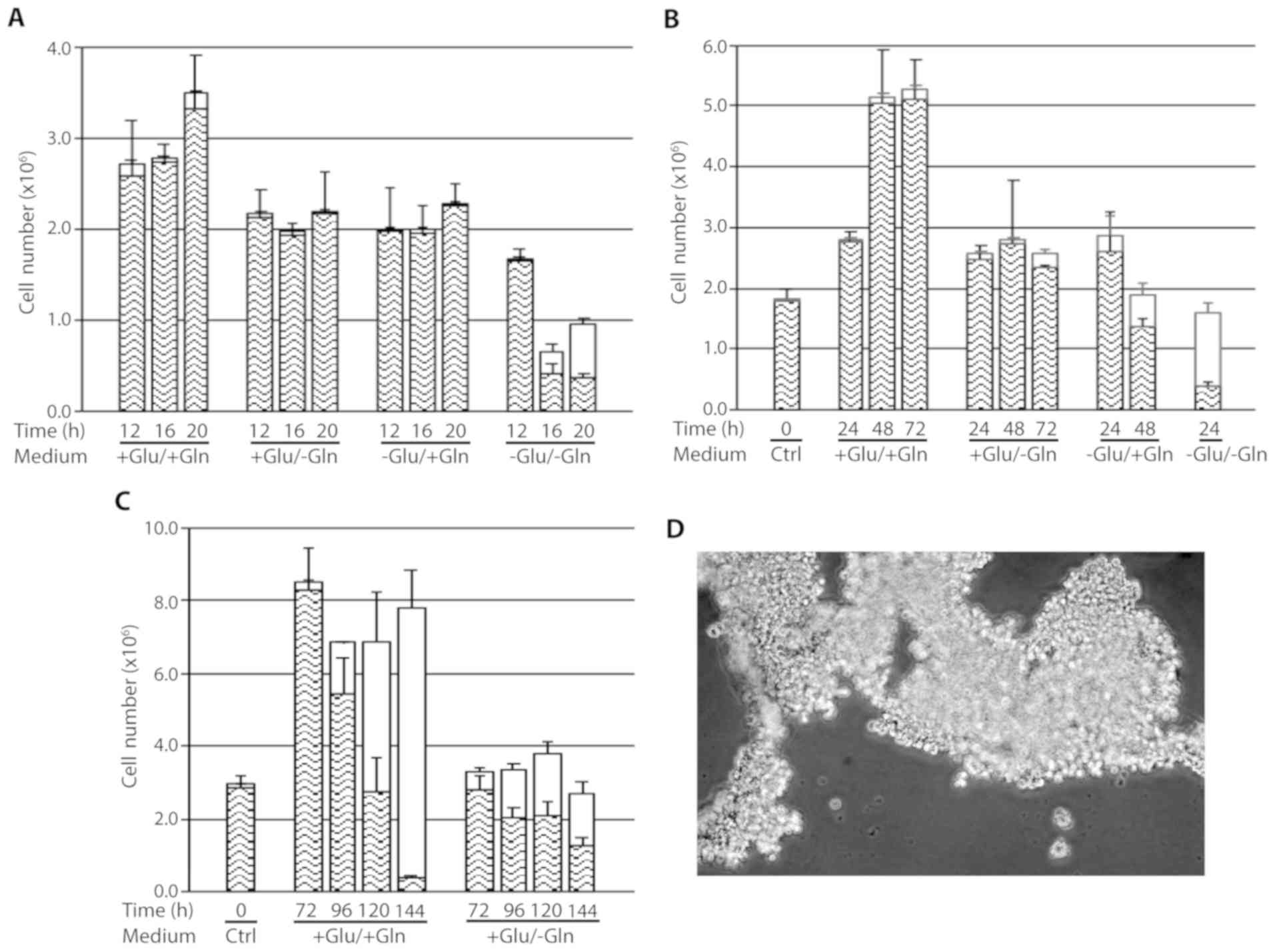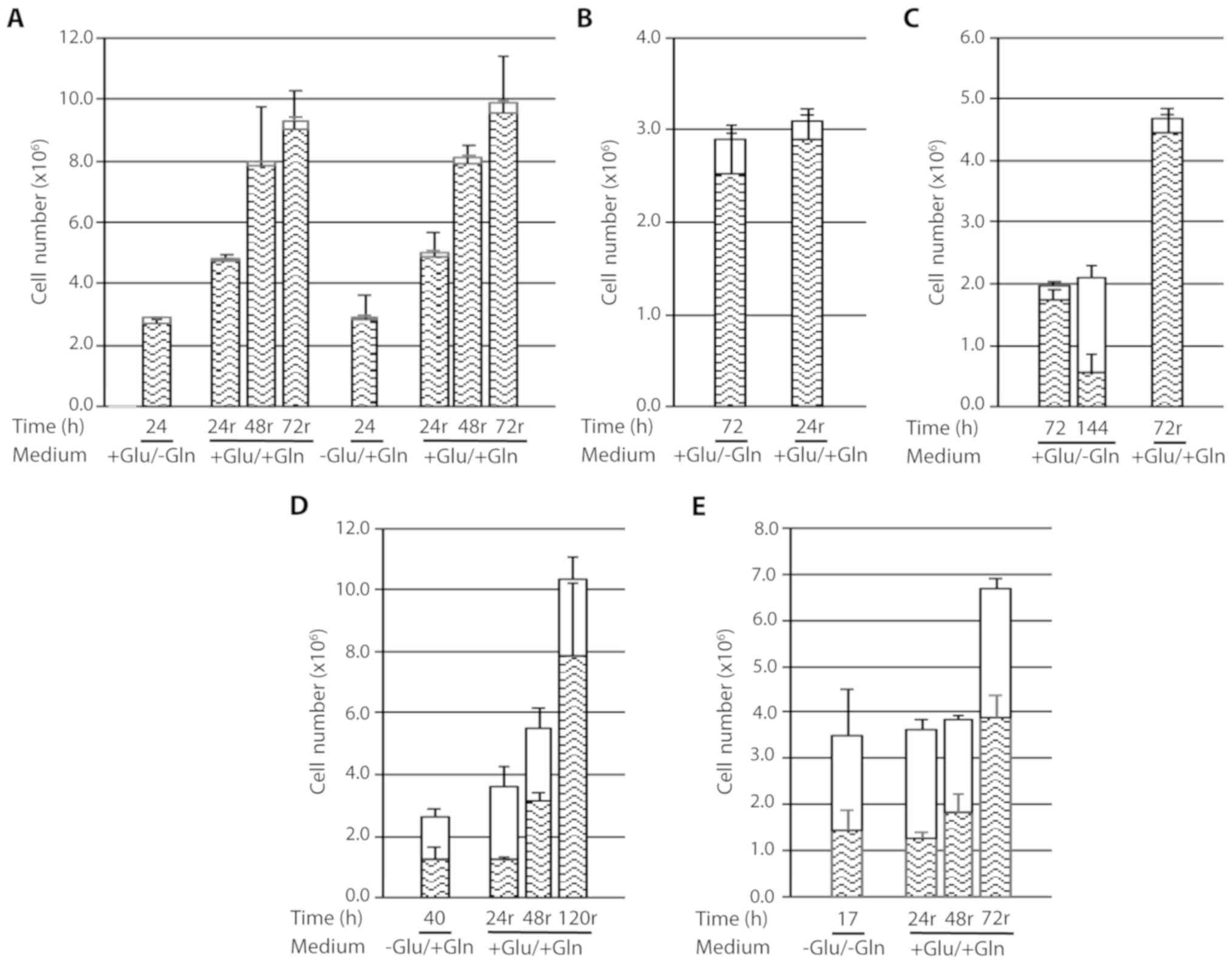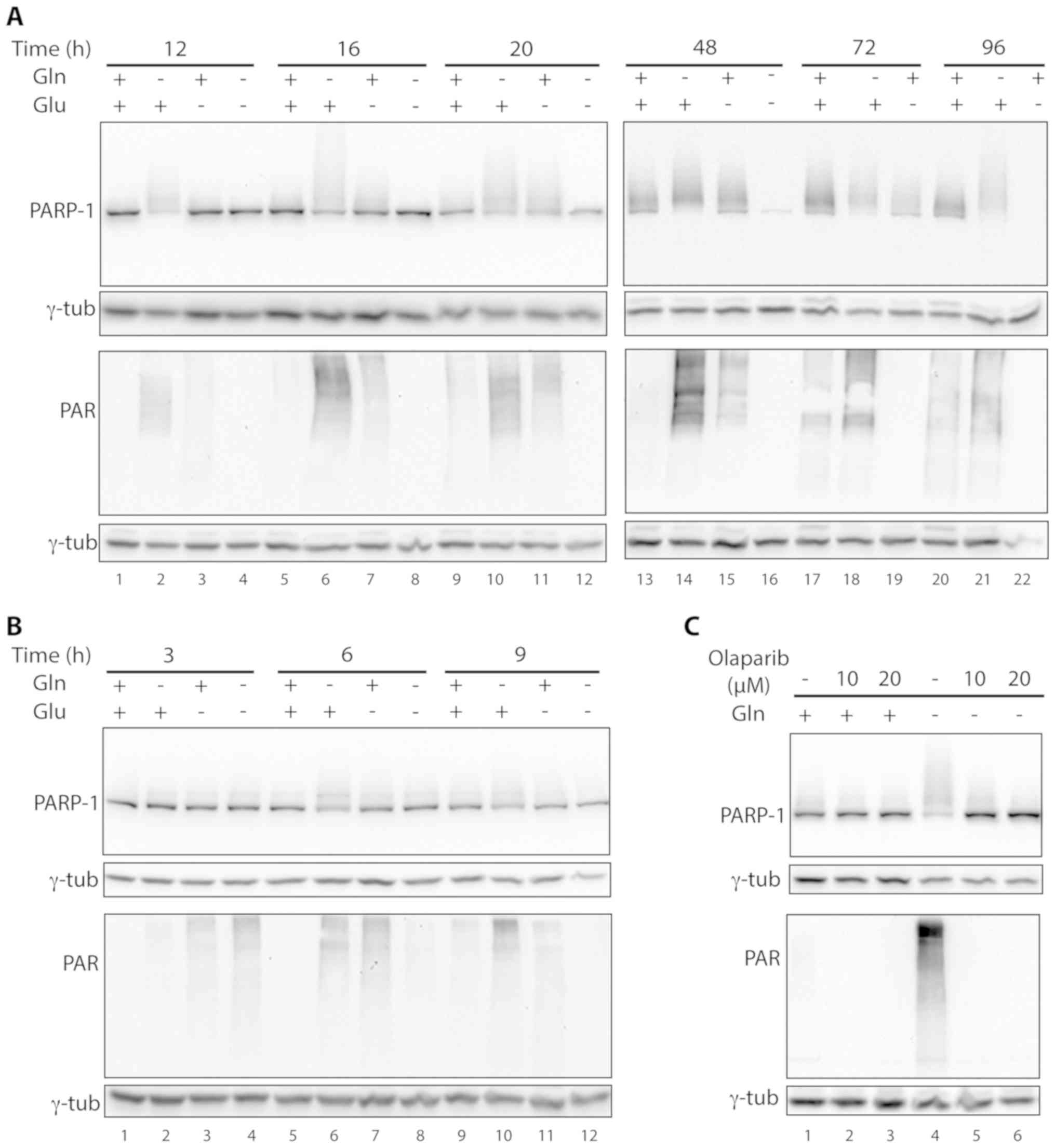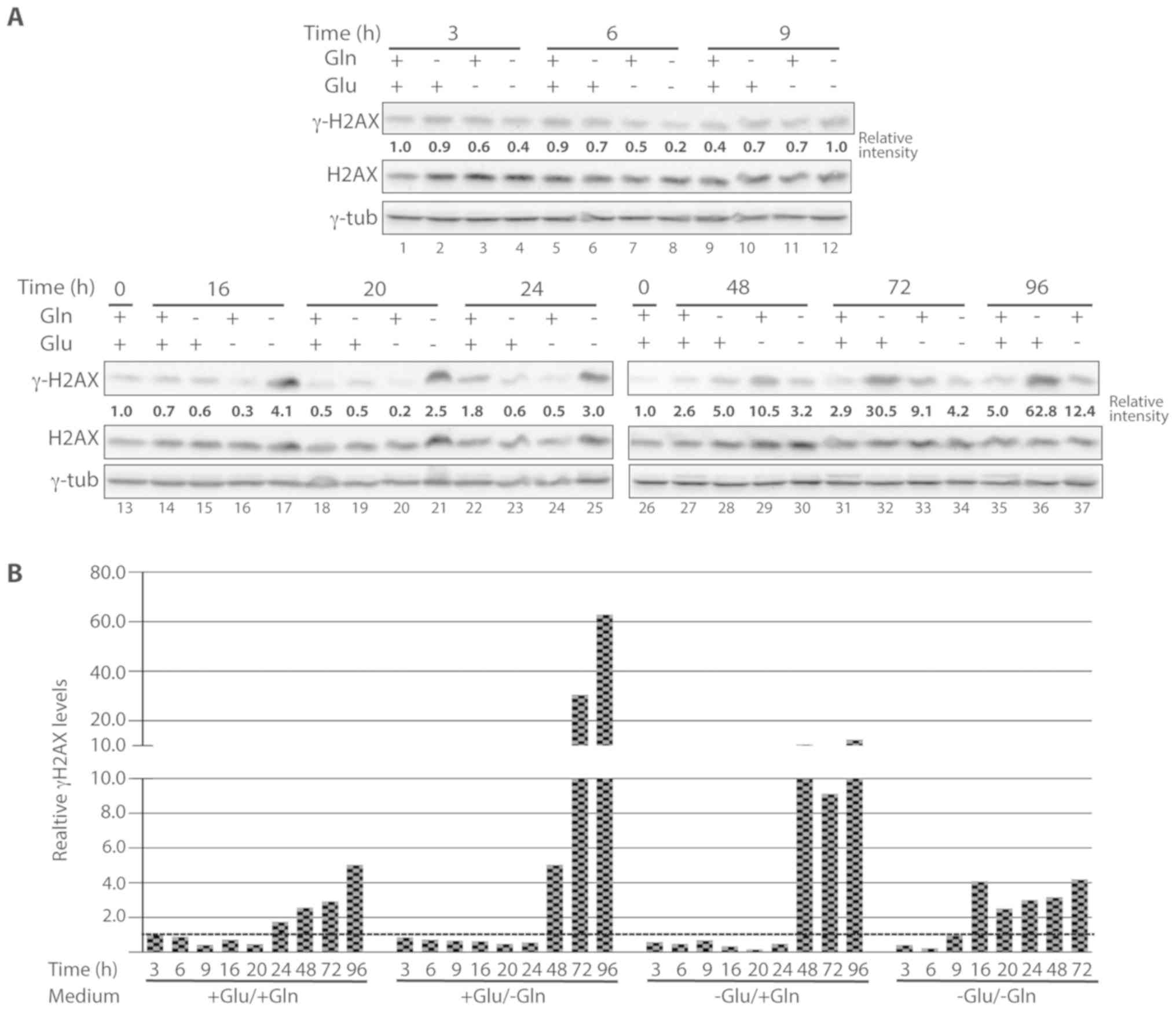|
1
|
Hanahan D and Weinberg RA: Hallmarks of
Cancer: The next generation. Cell. 144:646–674. 2011. View Article : Google Scholar : PubMed/NCBI
|
|
2
|
Robey RB, Weisz J, Kuemmerle NB, Salzberg
AC, Berg A, Brown DG, Kubik L, Palorini R, Al-Mulla F, Al-Temaimi
R, et al: Metabolic reprogramming and dysregulated metabolism:
Cause, consequence and/or enabler of environmental carcinogenesis?
Carcinogenesis. 36 (Suppl 1):S203–S231. 2015. View Article : Google Scholar : PubMed/NCBI
|
|
3
|
Pavlova NN and Thompson CB: The emerging
hallmarks of cancer metabolism. Cell Metab. 23:27–47. 2016.
View Article : Google Scholar : PubMed/NCBI
|
|
4
|
Warburg O: On the origin of cancer cells.
Science. 123:309–314. 1956. View Article : Google Scholar : PubMed/NCBI
|
|
5
|
Daye D and Wellen KE: Metabolic
reprogramming in cancer: Unraveling the role of glutamine in
tumorigenesis. Semin Cell Dev Biol. 23:362–369. 2012. View Article : Google Scholar : PubMed/NCBI
|
|
6
|
Jones DP and Sies H: The redox code.
Antioxid Redox Signal. 23:734–746. 2015. View Article : Google Scholar : PubMed/NCBI
|
|
7
|
Altman BJ, Stine ZE and Dang CV: From
Krebs to clinic: Glutamine metabolism to cancer therapy. Nat Rev
Cancer. 16:619–634. 2016. View Article : Google Scholar : PubMed/NCBI
|
|
8
|
Wolpaw AJ and Dang CV: Exploiting
metabolic vulnerabilities of cancer with precision and accuracy.
Trends Cell Biol. 28:201–212. 2018. View Article : Google Scholar : PubMed/NCBI
|
|
9
|
Fuchs BC and Bode BP: Stressing out over
survival: Glutamine as an apoptotic modulator. J Surg Res.
131:26–40. 2006. View Article : Google Scholar : PubMed/NCBI
|
|
10
|
Yuneva M, Zamboni N, Oefner P,
Sachidanandam R and Lazebnik Y: Deficiency in glutamine but not
glucose induces MYC-dependent apoptosis in human cells. J Cell
Biol. 178:93–105. 2007. View Article : Google Scholar : PubMed/NCBI
|
|
11
|
Shanware NP, Bray K, Eng CH, Wang F,
Follettie M, Myers J, Fantin VR and Abraham RT: Glutamine
deprivation stimulates mTOR-JNK-dependent chemokine secretion. Nat
Commun. 5:49002014. View Article : Google Scholar : PubMed/NCBI
|
|
12
|
Choi SW, Song JK, Yim YS, Yun HG and Chun
KH: Glucose deprivation triggers Protein kinase C Dependent
β-catenin proteasomal degradation. J Biol Chem. 290:9863–9873.
2015. View Article : Google Scholar : PubMed/NCBI
|
|
13
|
Mondello C, Chiesa M, Rebuzzini P, Zongaro
S, Verri A, Colombo T, Giulotto E, D'Incalci M, Franceschi C and
Nuzzo F: Karyotype instability and anchorage-independent growth in
telomerase-immortalized fibroblasts from two centenarian
individuals. Biochem Biophys Res Commun. 308:914–921. 2003.
View Article : Google Scholar : PubMed/NCBI
|
|
14
|
Zongaro S, de Stanchina E, Colombo T,
D'Incalci M, Giulotto E and Mondello C: Stepwise neoplastic
transformation of a telomerase immortalized fibroblast cell line.
Cancer Res. 65:11411–11418. 2005. View Article : Google Scholar : PubMed/NCBI
|
|
15
|
Belgiovine C, Frapolli R, Bonezzi K,
Chiodi I, Favero F, Mello-Grand M, Dei Tos AP, Giulotto E,
Taraboletti G, D'Incalci M and Mondello C: Reduced expression of
the rOCK inhibitor Rnd3 Is associated with increased invasiveness
and metastatic potential in mesenchymal tumor cells. PLoS One.
5:e141542010. View Article : Google Scholar : PubMed/NCBI
|
|
16
|
Ostano P, Bione S, Belgiovine C, Chiodi I,
Ghimenti C, Scovassi AI, Chiorino G and Mondello C: Cross-analysis
of gene and miRNA genome-wide expression profiles in human
fibroblasts at different stages of transformation. OMICS. 16:24–36.
2012. View Article : Google Scholar : PubMed/NCBI
|
|
17
|
Gao P, Tchernyshyov I, Chang TC, Lee YS,
Kita K, Ochi T, Zeller KI, De Marzo AM, Van Eyk JE, Mendell JT and
Dang CV: c-Myc suppression of miR-23a/b enhances mitochondrial
glutaminase expression and glutamine metabolism. Nature.
458:762–765. 2009. View Article : Google Scholar : PubMed/NCBI
|
|
18
|
Belgiovine C, Chiodi I and Mondello C:
Relocalization of cell adhesion molecules during neoplastic
transformation of human fibroblasts. Int J Oncol. 39:1199–1204.
2011.PubMed/NCBI
|
|
19
|
Chiodi I, Belgiovine C, Zongaro S, Ricotti
R, Horard B, Lossani A, Focher F, Gilson E, Giulotto E and Mondello
C: Super-telomeres in transformed human fibroblasts. Biochim
Biophys Acta. 1833:1885–1893. 2013. View Article : Google Scholar : PubMed/NCBI
|
|
20
|
Belgiovine C, Chiesa G, Chiodi I, Frapolli
R, Bonezzi K, Taraboletti G, D'Incalci M and Mondello C: Snail
levels control the migration mechanism of mesenchymal tumor cells.
Oncol Lett. 12:767–771. 2016. View Article : Google Scholar : PubMed/NCBI
|
|
21
|
Mizushima N, Yoshimori T and Levine B:
Methods in mammalian autophagy research. Cell. 140:313–326. 2010.
View Article : Google Scholar : PubMed/NCBI
|
|
22
|
Codogno P, Mehrpour M and Proikas-Cezanne
T: Canonical and non-canonical autophagy: Variations on a common
theme of self-eating? Nat Rev Mol Cell Biol. 13:7–12. 2011.
View Article : Google Scholar : PubMed/NCBI
|
|
23
|
Ward TH, Cummings J, Dean E, Greystoke A,
Hou JM, Backen A, Ranson M and Dive C: Biomarkers of apoptosis. Br
J Cancer. 99:841–846. 2008. View Article : Google Scholar : PubMed/NCBI
|
|
24
|
Bryant HE, Schultz N, Thomas HD, Parker
KM, Flower D, Lopez E, Kyle S, Meuth M, Curtin NJ and Helleday T:
Specific killing of BRCA2-deficient tumours with inhibitors of
poly(ADP-ribose) polymerase. Nature. 434:913–917. 2005. View Article : Google Scholar : PubMed/NCBI
|
|
25
|
Farmer H, McCabe N, Lord CJ, Tutt AN,
Johnson DA, Richardson TB, Santarosa M, Dillon KJ, Hickson I,
Knights C, et al: Targeting the DNA repair defect in BRCA mutant
cells as a therapeutic strategy. Nature. 434:917–921. 2005.
View Article : Google Scholar : PubMed/NCBI
|
|
26
|
Kuo LJ and Yang LX: Gamma-H2AX-a novel
biomarker for DNA double-strand breaks. In Vivo. 22:305–309.
2008.PubMed/NCBI
|
|
27
|
Bono B, Ostano P, Peritore M, Gregnanin I,
Belgiovine C, Liguori M, Allavena P, Chiorino G, Chiodi I and
Mondello C: Cells with stemness features are generated from in
vitro transformed human fibroblasts. Sci Rep. 8:138382018.
View Article : Google Scholar : PubMed/NCBI
|
|
28
|
McGuire EJ: Intercellular adhesive
selectivity. II. Properties of embryonic chick liver cell-cell
adhesion. J Cell Biol. 68:90–100. 1976. View Article : Google Scholar : PubMed/NCBI
|
|
29
|
Fu YM, Zhang H, Ding M, Li YQ, Fu X, Yu ZX
and Meadows GG: Specific amino acid restriction inhibits attachment
and spreading of human melanoma via modulation of the
integrin/focal adhesion kinase pathway and actin cytoskeleton
remodeling. Clin Exp Metastasis. 21:587–598. 2004. View Article : Google Scholar : PubMed/NCBI
|
|
30
|
Galluzzi L, Pietrocola F, Levine B and
Kroemer G: Metabolic control of autophagy. Cell. 159:1263–1276.
2014. View Article : Google Scholar : PubMed/NCBI
|
|
31
|
Gupte R, Liu Z and Kraus WL: PARPs and
ADP-ribosylation: Recent advances linking molecular functions to
biological outcomes. Genes Dev. 31:101–126. 2017. View Article : Google Scholar : PubMed/NCBI
|
|
32
|
Scherz-Shouval R, Shvets E, Fass E, Shorer
H, Gil L and Elazar Z: Reactive oxygen species are essential for
autophagy and specifically regulate the activity of Atg4. EMBO J.
26:1749–1760. 2007. View Article : Google Scholar : PubMed/NCBI
|
|
33
|
Rodríguez-Vargas JM, Ruiz-Magaña MJ,
Ruiz-Ruiz C, Majuelos-Melguizo J, Peralta-Leal A, Rodríguez MI,
Muñoz-Gámez JA, de Almodóvar MR, Siles E, Rivas AL, et al:
ROS-induced DNA damage and PARP-1 are required for optimal
induction of starvation-induced autophagy. Cell Res. 22:1181–1198.
2012. View Article : Google Scholar : PubMed/NCBI
|
|
34
|
Tran TQ, Ishak Gabra MB, Lowman XH, Yang
Y, Reid MA, Pan M, O'Connor TR and Kong M: Glutamine deficiency
induces DNA alkylation damage and sensitizes cancer cells to
alkylating agents through inhibition of ALKBH enzymes. PLoS Biol.
15:e20028102017. View Article : Google Scholar : PubMed/NCBI
|
|
35
|
Hruda J, Sramek V and Leverve X: High
glucose increases susceptibility to oxidative-stress-induced
apoptosis and DNA damage in K-562 cells. Biomed Pap Med Fac Univ
Palacky Olomouc Czech Repub. 154:315–320. 2010. View Article : Google Scholar : PubMed/NCBI
|
|
36
|
Aguilera-Gomez A, van Oorschot MM,
Veenendaal T and Rabouille C: In vivo vizualisation of
mono-ADP-ribosylation by dPARP16 upon amino-acid starvation. Elife.
5:e214752016. View Article : Google Scholar : PubMed/NCBI
|




















